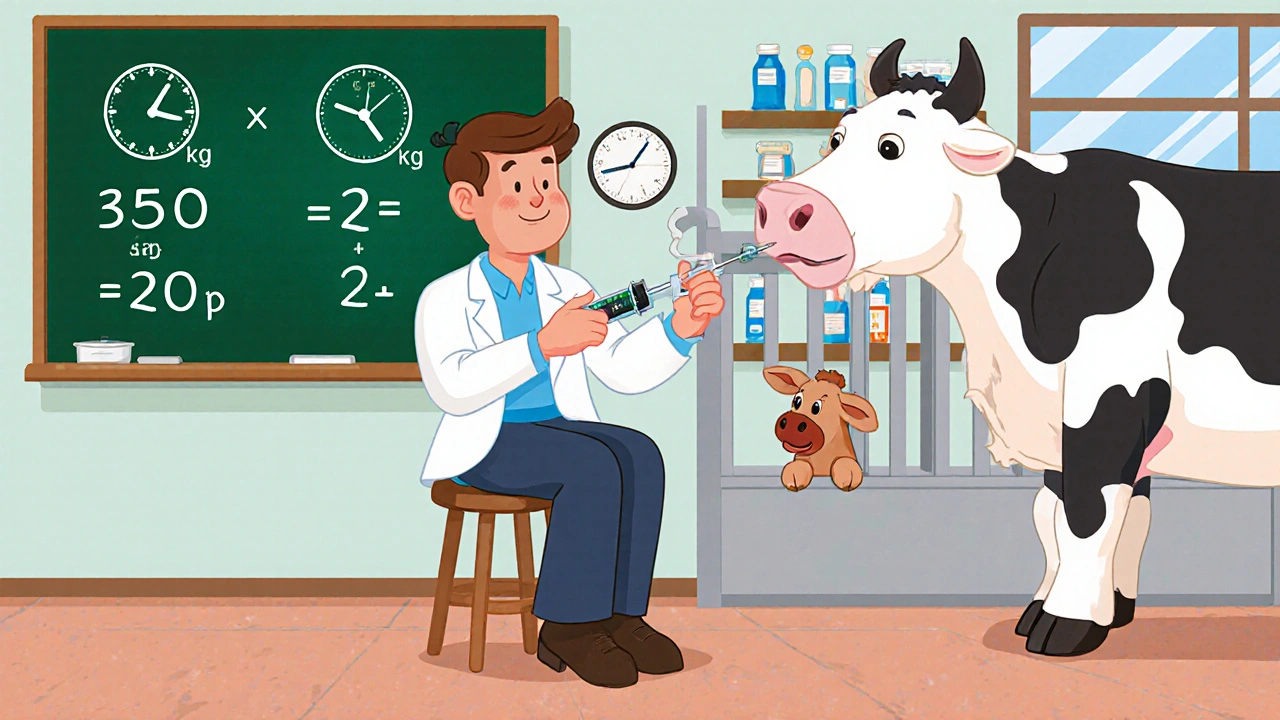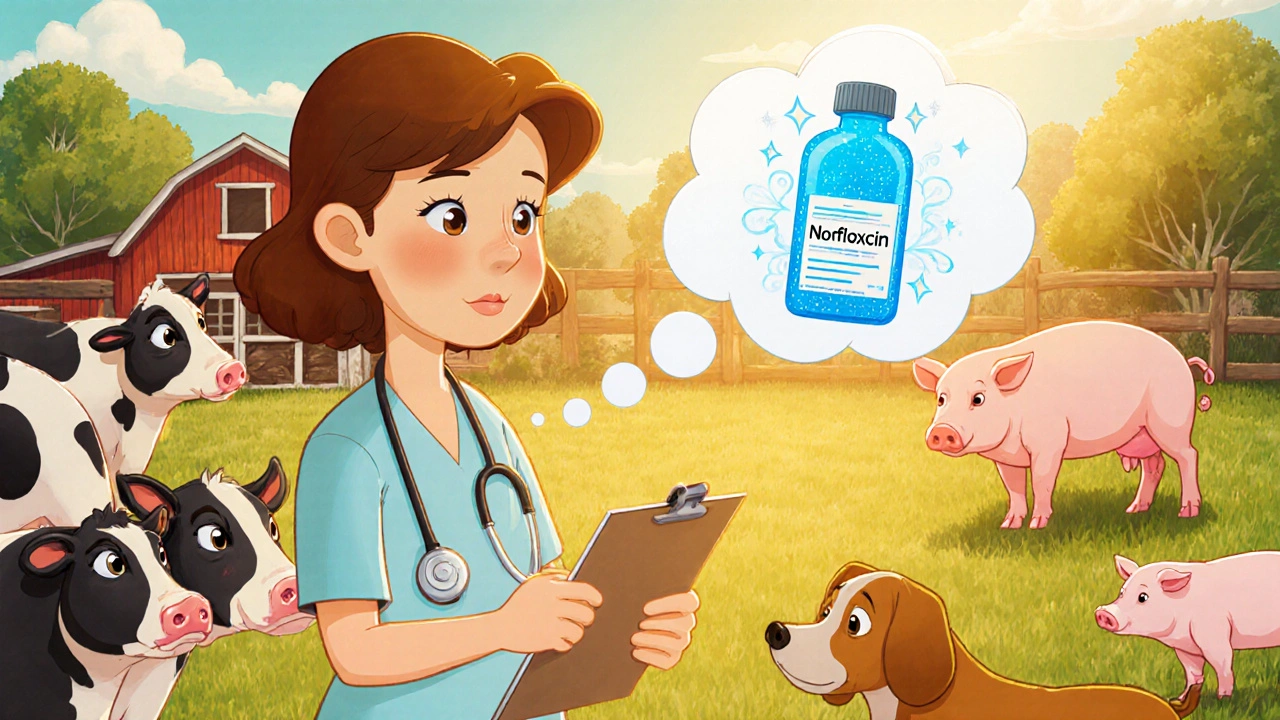When a veterinarian faces a bacterial outbreak in a herd, the choice of antibiotic can make or break the treatment plan. Norfloxacin is a broad‑spectrum fluoroquinolone used to treat a range of Gram‑negative and some Gram‑positive infections in animals.
Quick Takeaways
- Effective against Escherichia coli and Salmonella infections in cattle, swine, and dogs.
- Dosage varies by species; always follow the weight‑based regimen.
- Observe the mandatory withdrawal period for food‑producing animals to avoid drug residues in meat, milk, or eggs.
- Watch for signs of tendonitis, neurologic signs, or gastrointestinal upset - common fluoroquinolone side effects.
- Prudent use helps curb Antimicrobial resistance in veterinary settings.
What is Norfloxacin?
Norfloxacin belongs to the fluoroquinolone class, which works by inhibiting bacterial DNA gyrase and topoisomerase IV, enzymes essential for DNA replication. First approved for human use in the early 1980s, its spectrum and pharmacokinetics made it attractive for animal health, especially when rapid bacterial kill is needed.
Role of Fluoroquinolones in Veterinary Medicine
Within Veterinary medicine the practice of diagnosing, treating, and preventing disease in animals, fluoroquinolones sit behind a strict stewardship framework. The WHO’s Critically Important Antimicrobials list flags them as “Highest Priority”, urging clinicians to reserve them for infections that lack safer alternatives.
Common Veterinary Uses
In practice, Norfloxacin tackles infections where Gram‑negative bacteria dominate. Typical scenarios include:
- Enteric colibacillosis in neonatal calves caused by Escherichia coli.
- Salmonella enteritis in swine, often linked to feed contamination.
- Urinary tract infections in dogs and cats, especially those caused by Pseudomonas spp.
- Respiratory infections in poultry when other antibiotics fail, though regulatory limits are tighter.
Because it concentrates well in urine and intestinal fluids, Norfloxacin achieves therapeutic levels with relatively low dosing frequency.

Dosage Guidelines by Species
Dosage must be calculated per kilogram of body weight and adjusted for the animal’s renal function. Below is a snapshot of commonly recommended regimens:
| Species | Indication | Dose | Frequency | Withdrawal Period |
|---|---|---|---|---|
| Cattle (beef) | Enteric colibacillosis | 5-10 | Every 24 h | 28 days (meat) |
| Swine | Salmonella gastroenteritis | 7-12 | Every 24 h | 14 days (meat) |
| Dog | UTI (uncomplicated) | 5 | Every 12 h | None (companion animal) |
| Cat | UTI (complicated) | 8-10 | Every 24 h | None (companion animal) |
These numbers are guidelines; individual cases may require adjustment based on culture‑sensitivity results and the animal’s health status.
Precautions and Contra‑indications
Even though Norfloxacin is generally safe, several red flags demand extra vigilance:
- Pregnant or lactating animals: Fluoroquinolones can cross the placenta and appear in milk, potentially affecting offspring development.
- Young animals: Tendon and cartilage damage have been reported in growing calves and puppies, mirroring human pediatric concerns.
- Renal impairment: Reduced clearance raises plasma levels, increasing the risk of neurotoxicity.
- Concurrent use of NSAIDs: Heightened risk of seizures and gastrointestinal ulcers.
Always perform a baseline blood work panel when treating high‑risk patients. If adverse signs such as ataxia, vomiting, or swollen joints appear, discontinue therapy immediately.
Withdrawal Periods for Food‑Producing Animals
Regulators like Health Canada oversees drug approval and residue limits for Canadian livestock enforce strict withdrawal periods to protect consumers. The periods listed in the table above reflect the longest documented residue persistence in muscle, liver, and kidney tissue. Failure to observe these timelines can result in product recalls, fines, and loss of consumer confidence.

Impact on Antimicrobial Resistance (AMR)
Every dose of a fluoroquinolone adds pressure on bacterial populations. Misuse-such as under‑dosing, treating viral infections, or using the drug without culture confirmation-accelerates the emergence of resistant strains. Veterinarians can mitigate AMR by:
- Confirming bacterial etiology with laboratory testing before starting therapy.
- Choosing the narrowest effective spectrum antibiotic whenever possible.
- Adhering to recommended treatment durations; longer courses do not necessarily improve outcomes.
- Educating farm workers about proper drug storage and administration.
Monitoring Treatment Success
Effective therapy shows clinical improvement within 48-72 hours. Objective measures include:
- Normalization of rectal temperature.
- Resolution of diarrhea or dysuria.
- Negative follow‑up cultures after the last dose.
If signs persist beyond the expected window, reassess the diagnosis, consider alternative pathogens, and verify that the dosage was calculated correctly.
Frequently Asked Questions
Can I use Norfloxacin in poultry?
Yes, but only under a veterinary prescription and with a strict withdrawal period (often 21 days). Some countries have banned fluoroquinolones in layers due to residue concerns.
What is the difference between Norfloxacin and Enrofloxacin?
Both are fluoroquinolones, but Enrofloxacin is metabolized to Ciprofloxacin in many species, offering a broader safety margin in some cases. Norfloxacin is less commonly used in poultry but remains popular for cattle and swine.
How do I calculate the dose for a 350‑kg cow?
If the prescribed regimen is 7 mg/kg once daily, multiply 350 kg × 7 mg = 2,450 mg per dose. Split the amount into two oral syringes if needed for accurate administration.
Is there a risk of tendon rupture in dogs?
While rare, fluoroquinolones can affect tendon integrity, especially in large, active breeds. Monitor for limping or swelling and discontinue the drug if symptoms appear.
What should I do if residues are found in milk?
Immediately cease milk sales, notify the regulatory authority, and follow the mandated disposal or testing protocol. The animal will need to complete the full withdrawal period before milk can be marketed again.
Bottom Line for Veterinarians
When used responsibly, Norfloxacin offers a powerful tool against stubborn Gram‑negative infections in a variety of species. The key is to respect dosage guidelines, honor withdrawal periods for food‑producing animals, and stay alert to side‑effects. By integrating culture‑based decisions and antimicrobial‑stewardship principles, you can protect both animal health and public safety.


Erin Leach
October 26, 2025
When you’re juggling a herd with a sudden bacterial surge, the pressure to pick the right antibiotic can feel overwhelming.
Norfloxacin’s broad‑spectrum activity makes it a tempting option, especially against E. coli and Salmonella.
But the decision should start with a solid diagnosis – culture and sensitivity are worth the extra day.
A weight‑based dose calculated to the kilogram keeps plasma levels therapeutic without overexposing the animal.
Remember that the withdrawal period isn’t just paperwork; it protects the consumer and the farm’s reputation.
For beef cattle a 28‑day meat withdrawal is the rule, and cutting it short can land you in a recall nightmare.
Swine have a shorter 14‑day window, yet the same principle applies – no shortcuts.
In companion animals like dogs, there’s no withdrawal, but you still need to watch for tendon or neurologic signs.
Fluoroquinolones can irritate cartilage in growing calves and puppies, so limit use in young stock.
If you see any limping, joint swelling, or unusual behavior, pull the drug and reassess immediately.
Renal impairment can raise drug concentrations, so a baseline blood panel is a smart move before you start therapy.
Combining NSAIDs with Norfloxacin raises the risk of seizures, another reason to double‑check the medication list.
Good antimicrobial stewardship means reserving fluoroquinolones for cases where safer drugs won’t work.
Overuse fuels resistance, and that resistance can travel from farm to clinic, affecting human health.
Educating farm workers on proper storage and administration can make a big difference in keeping resistance low.
In short, use Norfloxacin responsibly, respect dosages and withdrawal times, and stay vigilant for side effects – that’s the best way to keep both your animals and your customers safe.
Nic Floyd
November 1, 2025
Norfloxacin is a fluoroquinolone that targets DNA gyrase and topoisomerase IV enabling rapid bactericidal action 🚀 its spectrum covers Gram‑negative rods particularly E coli and Salmonella which are common in intensive livestock operations dosage is expressed in mg per kg and frequency is typically q24h for cattle and swine adjustments are made for renal clearance 🧬 remember withdrawal periods are regulatory mandates not suggestions 28 days for beef muscle 14 days for pork tissue compliance avoids market penalties 📈
Manoj Kumar
November 7, 2025
Ah, the noble quest for the perfect antibiotic – because what’s more thrilling than a bottle of fluoroquinolone in a world of resistant microbes?
Sure, Norfloxacin kills bacteria faster than a caffeine‑driven intern finishes paperwork, but let’s not pretend it’s a magic wand.
If you treat every outbreak with it, you’ll soon have a herd of superbugs that could outsmart a chess grandmaster.
Think of it as borrowing the universe’s cheat code – fun for a round, disastrous for the sequel.
So maybe, just maybe, reserve it for those truly stubborn infections that other drugs can’t touch.
Hershel Lilly
November 13, 2025
That’s a solid point about stewardship – using culture data helps keep fluoroquinolones effective longer.
Rhea Lesandra
November 19, 2025
Let’s talk dosage specifics because the numbers can get confusing, especially when you’re dealing with multiple species.
For a 350‑kg beef cow the typical 7 mg/kg regimen works out to about 2.45 g per day, which you can split into two oral doses for easier administration.
If you’re treating a 25‑kg piglet, the 7–12 mg/kg range translates to roughly 200‑300 mg per day, usually given once daily.
Dogs with uncomplicated UTIs get a steady 5 mg/kg every 12 hours, so a 20‑kg Labrador would need about 100 mg per dose.
In cats, especially those with complicated infections, you might see 8‑10 mg/kg once a day, meaning a 5‑kg cat would get 40‑50 mg daily.
Always double‑check the withdrawal periods: 28 days for beef meat, 14 days for pork, and none for companion animals, but keep an eye on any off‑label uses that could alter those timelines.
Finally, monitor the animal closely – if you notice any signs of tendon pain, neuro‑symptoms, or gastrointestinal upset, stop the drug and reassess.
Lori Brown
November 24, 2025
Great breakdown! 🙌 Remember to log the exact times you give each dose – it makes withdrawal calculations a breeze :)
Jacqui Bryant
November 30, 2025
Use the correct withdrawal period.
Paul Luxford
December 6, 2025
That reminder is helpful; staying on top of the schedule avoids costly recalls.